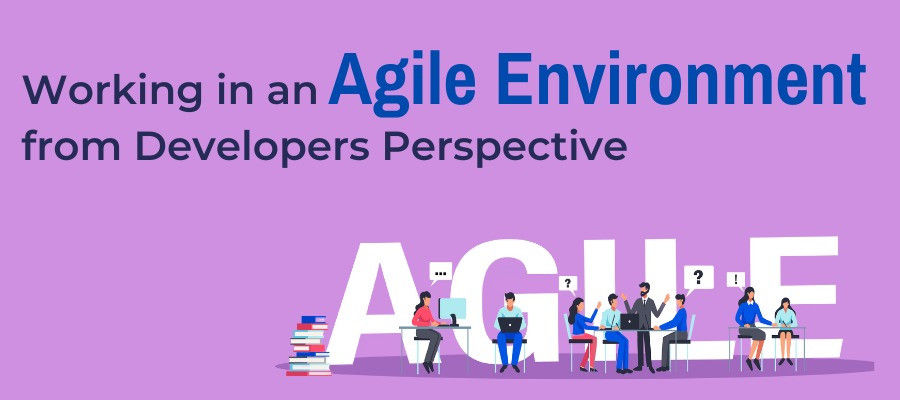Working in an Agile Environment from Developers Perspective

Agile Methodologies such as Scrum, Extreme Programming, Kanban, etc. are taking over old project management approaches. Now the Product Owner sets up the Product Goal for the Developers to work on. While the Project Manager focuses on reducing development costs with increased stakeholder engagement, the development team works to improve code quality and manage code failures. All of this is for bringing the best outcomes from the business perspective. If are new to the development team as an Agile Beginner, you need to know what’s like to develop software while working in an Agile Environment. This guide discusses how effective is Agile methodology to enhance a developer’s day-to-day work life!
What is Agile Development?
Agile Development is an iterative software/application development approach. Now, what does it mean? Agile Development focuses on Continuous Development to reduce the Software Development Life Cycle (SDLC). Continuous Development also helps the Developers to improve the code quality and eliminate potential code defects with frequent code releases. The development team follows the Sprint Goal to complete the work items in shorter increments during one Sprint. Hence, Agile Development eliminates all the drawbacks of the traditional waterfall model of software/application development. The best part is; Agile Development is suitable for all types of projects.
Getting Introduced to The Responsibilities of An Agile Developer:
The roles and responsibilities of an Agile Developer are yet not well understood by many professional Developers. If you are one of such people, you might find it difficult to utilize various Agile tools and approaches for development activities. In Agile Development, it isn’t just about writing code and doing hard-core programming. Here is a complete briefing of the responsibilities of an Agile Developer in Agile Project Management.
1. Taking responsibility for assigned tasks:
During Sprint Planning, the Scrum Master distributes User Stories among the development team members to work on. As an active developer, take accountability for the assigned tasks by your name. Work on the Product Backlog Items to raise Story Points. Estimate your capacity and work hours that are required to complete the assigned activities before the Sprint ends. Next, plan the task execution process and discuss with your team if you face any blockers/challenges to completing a User Story. Lastly, don’t forget to report the progress of your tasks during the Daily Scrum meeting.
2. Facilitate effective teamwork:
Agile Teams have complete visibility of the Product Goal to establish with Continuous Development. Every team member knows who is working on which User Story and what are the active Work Items for the Sprint. With clear transparency, the Developers can collaborate closely with the software/application team and system admins to reach the Definition of Done. So it becomes easier for the teams to communicate with each other and take shared responsibility as per the Sprint Commitments.
3. Improve Software Code Quality
Agile Development makes the process of Continuous Integration/Continuous Development faster and simpler for the Developers. DevOps tools allow easy source-code integration and updation facilities so that the development team can work on code bugs and defects to improve the code quality. They work over the local copy of the source code so that the software/application doesn’t face outages/downtime. Based on the code commits and code pushes, the testing team conducts testing and pushes the code changes to the Source Code Repository.
4. Clear Understanding of Product Vision
The Developers that follow the Agile Development Approach get a clear understanding of the ultimate Product Vision. The Product Owner consults with the stakeholders to provide a well-defined set of product feature requirements to the development team. Based on that, the Developers receive User Stories to start their development activities. With a clear mindset, the development team works to complete the end Product Goal.
Does Agile Help Developers In Solving Problems Faster?
The main Agile Manifesto Principle states that satisfying the customer demands should be the top priority of the Developers through continuous improvement and continuous delivery. Yes, an Agile Environment provides the Developers with all the necessary tools and techniques that are required to perform Continuous Integration/Continuous Development. Whenever there is a problem, the development team can work collaboratively with the other teams to fix the system defects and code errors. Indeed, Agile Environment helps Developers solve software defects faster than the traditional waterfall approach.
Summarizing The Developer’s Prospective:
As an Agile Practitioner, it’s your responsibility to take advantage of all Agile Methodologies to deliver top-notch software feature development solutions. Hopefully, you have understood the primary responsibilities of an Agile Developer. Certainly, you have gained a better view of the developer’s perspective while working in an Agile Environment. However, you might have to take on additional responsibilities that you never expected. So it’s best to keep Learning more about various Agile Techniques.
Reference
- https://learn.microsoft.com/en-us/devops/plan/what-is-agile-development



